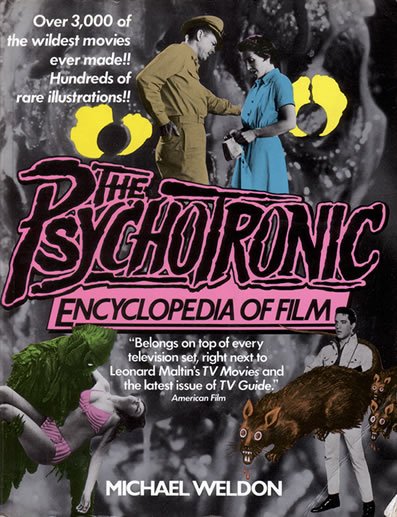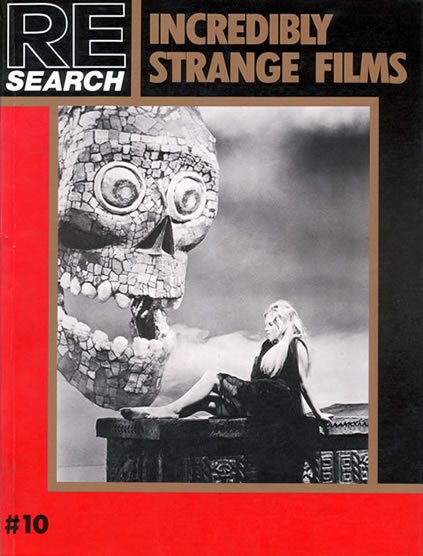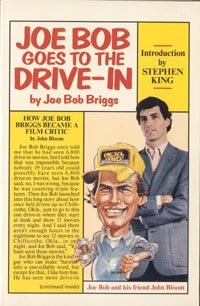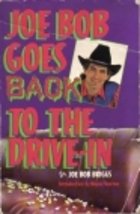THE BASIC SCHLOCK FILM BOOKSHELF, VOL. 1: The Holy Trinity
It took a long time for Your Humble Reviewer to develop the aesthetic that fuels this website. A key part of that development came from reading about cult movies. There were a lot of great writers whose pioneering work made it possible for me to find my own personal path to schlock.This is the first installment in what will be a six-part tribute to those writers and critics who helped shape my schlock aesthetic. The tomes covered in this series are essential for the bookshelf of any discerning schlock aficionado. If you are a neophyte, then beg, borrow or steal to get these classics. If you are well versed in schlock and don’t have these, they’re still worth a look because they are the kind of rare, truly insightful guides that you can return to again and again.First in this survey is a round-up of three authors who form a personal Holy Trinity of Crucial Schlock Influences. They blazed the trail that I follow and their scholarship is a worthy basis for anyone's schlock education.  THE PSYCHOTRONIC ENCYCLOPEDIA OF FILM by Michael Weldon (1983 – Ballantine): This was the alpha and the omega of cinematic scholarship for me as a young schlockateer. Weldon was the first writer to create a mainstream book that embraced a mass of seemingly unrelated cinematic flotsam, gave it a specialized label and offered a collection of capsule reviews to explain this self-made aesthetic. The result warped my young mind - and many others - in the best possible way. Over two decades later, Psychotronic still impresses. Weldon's reviewing style makes him the Joe Friday of schlock reviewing: each capsule review offers a punchy synthesis of facts and pithy opinions, delivered with a minimum of frills and zero pretension. The book is fleshed out with a series of cool black and white stills that often have captions derived from United Press stories detailing the unique promotional schemes that often accompanied these flicks. Readers should also take special note of the introductory autobiographical essay that opens the book – it’s the prototypical account of the kind of youthful obsessions that describe the upbringing of many a schlock fan. In short, The Psychotronic Encyclopedia Of Film remains a great place for the schlock neophyte to begin their education.
THE PSYCHOTRONIC ENCYCLOPEDIA OF FILM by Michael Weldon (1983 – Ballantine): This was the alpha and the omega of cinematic scholarship for me as a young schlockateer. Weldon was the first writer to create a mainstream book that embraced a mass of seemingly unrelated cinematic flotsam, gave it a specialized label and offered a collection of capsule reviews to explain this self-made aesthetic. The result warped my young mind - and many others - in the best possible way. Over two decades later, Psychotronic still impresses. Weldon's reviewing style makes him the Joe Friday of schlock reviewing: each capsule review offers a punchy synthesis of facts and pithy opinions, delivered with a minimum of frills and zero pretension. The book is fleshed out with a series of cool black and white stills that often have captions derived from United Press stories detailing the unique promotional schemes that often accompanied these flicks. Readers should also take special note of the introductory autobiographical essay that opens the book – it’s the prototypical account of the kind of youthful obsessions that describe the upbringing of many a schlock fan. In short, The Psychotronic Encyclopedia Of Film remains a great place for the schlock neophyte to begin their education.  RE/SEARCH #10: INCREDIBLY STRANGE FILMS Edited by Andrea Juno & V. Vale (1987 – ReSearch): This is the next logical step after The Psychotronic Encyclopedia Of Film. What that tome was to me in high school is what Incredibly Strange Films was to me in college: in other words, the more ambitious, more cerebral and (much) more eccentric big brother to Weldon’s book. It’s a comprehensive collection of essays and interviews that detail and explain schlock as an outsider-culture experience. I discovered so much beloved cinema with this book in hand – Larry Cohen, Russ Meyer, Jack Hill, the list goes ever on. All the writers, including many an early zine publisher, take a deadpan approach the subject that combines an offbeat intelligence with plentiful helpings of sly, subtle wit. Their writing is witty without being precious and intelligent without devolving into collegiate intellectual wankery. More importantly, Incredibly Strange Films made it possible for me to believe that I could speak about my love for schlock from a place of intelligence instead of having to treat it as an embarrassing, goofball hobby. In short, this is seminal stuff that remains every bit as visionary and mind-blowing as it was back in its day. If you like to think about your schlock, this is the book to pick up.
RE/SEARCH #10: INCREDIBLY STRANGE FILMS Edited by Andrea Juno & V. Vale (1987 – ReSearch): This is the next logical step after The Psychotronic Encyclopedia Of Film. What that tome was to me in high school is what Incredibly Strange Films was to me in college: in other words, the more ambitious, more cerebral and (much) more eccentric big brother to Weldon’s book. It’s a comprehensive collection of essays and interviews that detail and explain schlock as an outsider-culture experience. I discovered so much beloved cinema with this book in hand – Larry Cohen, Russ Meyer, Jack Hill, the list goes ever on. All the writers, including many an early zine publisher, take a deadpan approach the subject that combines an offbeat intelligence with plentiful helpings of sly, subtle wit. Their writing is witty without being precious and intelligent without devolving into collegiate intellectual wankery. More importantly, Incredibly Strange Films made it possible for me to believe that I could speak about my love for schlock from a place of intelligence instead of having to treat it as an embarrassing, goofball hobby. In short, this is seminal stuff that remains every bit as visionary and mind-blowing as it was back in its day. If you like to think about your schlock, this is the book to pick up.  JOE BOB GOES TO THE DRIVE IN/JOE BOB GOES BACK TO THE DRIVE IN by John Bloom (1986/1990 – Delacorte): The third (and most beloved) of my trinity of Crucial Schlock Influences is Joe Bob Briggs. Said tough-talking Texan is the alter ego of John Bloom, a gifted journalist who realized the best way to capture the essence of schlock was to reinvent himself as a character who could have only walked out of a schlock epic. Thus, the great Joe Bob Briggs was born, a character that soon became popular enough to host schlock-minded programs for the Movie Channel and TNT, supervise dvd’s of classic film flotsam and even act in flicks like Casino. These two volumes of film reviews from Bloom’s newspaper career capture the character of Briggs in all his glory as he barnstorms his way through virtually every schlock flick made during the 1980’s. Each film gets discussed in a fun, freewheeling style that dishes out plot info, colorful observations on the style and performances and plenty of addictive Briggs-invented descriptive expressions like “slime glopola”, “Spam in a cabin” and “aardvarking.” Better yet, each review is thoughtfully capped with a content guide that lists the number of breasts exposed, gallons of blood spilled, the exact amount of decapitations or dismemberments and any other specialized bit of gratuitousness (chopsocky, car stunts, hammy acting, etc.).
JOE BOB GOES TO THE DRIVE IN/JOE BOB GOES BACK TO THE DRIVE IN by John Bloom (1986/1990 – Delacorte): The third (and most beloved) of my trinity of Crucial Schlock Influences is Joe Bob Briggs. Said tough-talking Texan is the alter ego of John Bloom, a gifted journalist who realized the best way to capture the essence of schlock was to reinvent himself as a character who could have only walked out of a schlock epic. Thus, the great Joe Bob Briggs was born, a character that soon became popular enough to host schlock-minded programs for the Movie Channel and TNT, supervise dvd’s of classic film flotsam and even act in flicks like Casino. These two volumes of film reviews from Bloom’s newspaper career capture the character of Briggs in all his glory as he barnstorms his way through virtually every schlock flick made during the 1980’s. Each film gets discussed in a fun, freewheeling style that dishes out plot info, colorful observations on the style and performances and plenty of addictive Briggs-invented descriptive expressions like “slime glopola”, “Spam in a cabin” and “aardvarking.” Better yet, each review is thoughtfully capped with a content guide that lists the number of breasts exposed, gallons of blood spilled, the exact amount of decapitations or dismemberments and any other specialized bit of gratuitousness (chopsocky, car stunts, hammy acting, etc.). However, these reviews are only half the fun of these books – Bloom also created an elaborate alternate universe that the reviews are couched in, setting the stage for each southern-fried critique with a funny tale of redneck living that features such characters as Cherry Dilday, Rhett Beavers and Wanda Bodine. The style of these segments is best described as “Lewis Grizzard on a bender” and they add a ton of invaluable atmosphere to the Briggsian experience. Briggs also takes advantage of his fictional status to wage war on real-life fatheads: my favorite example is when he lashes out at San Francisco critic Peter Stack, who offends Briggs by writing a smart-alecky “backhanded compliment”-style review for his beloved fave, Basket Case. The combination of schlock insight and imaginative fiction make John Bloom a peerless scribe who has truly carved out his own personal corner of the schlock universe. Thus, each Joe Bob book is a must-read for any serious schlock fiend.
However, these reviews are only half the fun of these books – Bloom also created an elaborate alternate universe that the reviews are couched in, setting the stage for each southern-fried critique with a funny tale of redneck living that features such characters as Cherry Dilday, Rhett Beavers and Wanda Bodine. The style of these segments is best described as “Lewis Grizzard on a bender” and they add a ton of invaluable atmosphere to the Briggsian experience. Briggs also takes advantage of his fictional status to wage war on real-life fatheads: my favorite example is when he lashes out at San Francisco critic Peter Stack, who offends Briggs by writing a smart-alecky “backhanded compliment”-style review for his beloved fave, Basket Case. The combination of schlock insight and imaginative fiction make John Bloom a peerless scribe who has truly carved out his own personal corner of the schlock universe. Thus, each Joe Bob book is a must-read for any serious schlock fiend.


